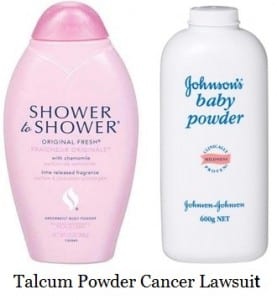 Talcum powder makers like Johnson & Johnson lobbied to “derail” efforts to classify talcum powder as a carcinogen. That’s what a Missouri jury heard Friday, Feb. 10, 2017 at a talcum powder ovarian cancer lawsuit trial in St. Louis.
Talcum powder makers like Johnson & Johnson lobbied to “derail” efforts to classify talcum powder as a carcinogen. That’s what a Missouri jury heard Friday, Feb. 10, 2017 at a talcum powder ovarian cancer lawsuit trial in St. Louis.Talc Trial Day 1
The first day in court for cancer survivor Nora Daniels began Feb. 9 with opening arguments from her lawyer and J&J defense lawyers. Jurors then watched two hours of deposition testimony from Johnson’s baby products manager Lorena Telofski, as well as testimony from Luzenac America’s Shripal Sharma. A forerunner of co-defendant Imerys Talc America, Luzenac was owned by mining mega-giant Rio Tinto from 1988 – 2011.
Ms. Daniels’ lawyers alleged on day one that Luzenac and the talc lobbying group Cosmetic, Toiletry and Fragrance Association, attacked and derailed regulator’ serious concerns through intense lobbying. According to Law 360, the lobbyists were responding to the National Toxicology Program’s 2000 nomination of talc for inclusion in its carcinogen inventory, the Report on Carcinogens, or RoC.
$10 Million per Year Potential Loss
Talc companies saw the proposed reclassification change as a make-or-break moment, said Ms. Daniels’ lawyer. An internal Luzenac PowerPoint said an NTP listing would cause a $10 million-per-year loss. A CTFA staffer issued an APB to the group’s Talc Task Force on the very day NTP announced its intent to make the talc cancer classification change.
Two NTP scientific groups had already voted overwhelmingly to list talc as a possible carcinogen. A final vote by the NTP’s Board of Scientific Counselors committee was coming in two months, according to an internal presentation by Luzenac health and safety head Steve Jarvis, shown during Sharma’s deposition. By the time that vote came, however, the talc industry had applied enough political muscle to stop the cancer listing change.
Talc Industry’s “Secret Weapon. . . very aggressive”
Mr. Jarvis boasted about “our secret weapon, [to] engage the services of the Washington-based Center for Regulatory Effectiveness,” according to the document.
Talc Companies “Very Aggressive” with Regulators
“We also became very aggressive in our communication with NTP and other federal agencies,” Mr. Jarvis’ speaking notes read. “[We] didn’t let the windows of ‘formal comment periods’ become restrictive. We sent emails, faxes, overnight letters and even telephone calls to key players in this battl. . . right up until hours before the final executive committee meeting. We achieved a very dramatic turnaround,” boasted Mr. Jarvis. The BSC committee voted 7-3 against listing talc, and the NTP backed off its review.
Talc Companies derail IARC Classification
Meanwhile, during Telofski’s deposition, plaintiffs’ lawyers made much of a Rio Tinto materials safety data sheet that grew out of another crucial moment: the classification of the World Health Organization agency IARC, of perineal (between the legs) talc use as a possible carcinogen.
Talc Powder Product Liability Lawsuit
IARC’s determination of talc as a potential carcinogen set off a scramble in the industry. Luzenac’s product safety director Rich Zazenski revealed in a March 2006 email, as the company was deciding whether to add a warning to its Material Safety Data Sheet, how concerned the companies should be about talc as a possible carcinogen, despite whatever regulatory requirements the lobbying groups could neutralize. Mr. Zazenski said (some might say presciently said), “Just meeting the regulatory requirements is not a sufficient defense in product liability lawsuits.”
Lies from CTFA Lobbyists
In another document shown Feb. 10, Alfred Wehner of the Academy of Toxicological Science, a consultant on retainer to J&J, wrote in a 1997 letter to J&J preclinical toxicology head Michael Chudkowski that two statements by the CTFA were lies.
The CTFA (now known as the Personal Care Products Council) in 1992 put out a release saying talc posed no risk , which was “outright false,” said Mr. Wehner. In addition, he wrote that a 1994 statement calling study results “insufficient to demonstrate any real association” was “also inaccurate, to phrase it euphemistically.”
Talc Lobbyists derailed Carcinogen Classification
The case is Swann v. Johnson & Johnson, case number 1422-CC09326-01, in the 22nd Judicial Circuit of Missouri.
RELATED
- Talcum Powder Cancer Attorney
- Talcum Powder Ovarian Cancer Link
- Talc Powder Cancer Lawsuit
- $72 Million Talc Cancer Verdict

by Matthews & Associates




